
Photo: Jonathan Sprague
In our latest Make Me a Ten! makeover, David L. Katz, MD cooks up a plan for a working mom hoping to establish a healthy diet for her family.
Brigid Shaheen knew that her family's eating habits were bad. She just didn't see a way to make them better. For starters, there was the time management problem. To feed her husband and two sons (ages 7 and 11), Brigid, a busy San Jose–based marketing professional, relied on frozen dinners, prepackaged snacks, fast food, and takeout—so much that she barely knew her way around her own kitchen. That led to her second problem: Brigid had little idea how to prepare fresh, healthy, delicious food that her family would enjoy.For breakfast, the kids gobbled down sugar-loaded cereals, while Brigid ate what she thought was a decent breakfast—an energy bar. She packed her sons' lunch boxes with sandwiches made with white bread. And the snacks she included—though she kept the portions small—were usually Oreos or Cheetos. For her own lunch, Brigid usually grabbed a frozen entrée on her way out the door. And for dinner, the family often hit the McDonald's drive-through or ordered pizza. On nights when Brigid had time to cook, she'd typically make white pasta topped with butter and salt.
Poor eating habits were clearly taking a toll on Brigid's health—she had gained weight and often felt depressed and lethargic—and she worried about the impact on her two young sons. When she saw a posting on Oprah.com looking for readers in need of a nutrition makeover, she nominated herself right away. "I want my kids to grow up having a solid understanding of nutrition, and I feel like I'm failing miserably," she wrote.
Just a few weeks later, Brigid found herself on the phone with O' s nutrition columnist, David L. Katz, MD . After hearing about the family's eating habits and busy schedule, Katz explained that although creating nutritious meals would take a little more time than Brigid was used to, it might not be as tough as she feared. "A report from UCLA showed that a home-cooked dinner takes only about ten minutes more than a dinner made from convenience foods," he says. "And if you keep at it, your body will reward you with more energy, a better mood, and a smaller waistline."
Katz also advised Brigid to get the whole family involved. "If you can do that, you're not just starting a diet, you're reengineering the way your family eats."
Dr. Katz's recipe for success

Photo: Jonathan Sprague
Engage everyone. In the past, Brigid's husband, Rodger, had resisted her efforts to improve the family's eating habits. When the kids would beg for fast food or sweets, he'd give in—partly because he liked those foods himself. Katz advised Brigid to explain to Rodger that America's children are experiencing an epidemic of diabetes and obesity, and it's part of their job as parents to protect their own boys from that fate. Brigid also let her sons know that when she asks them to eat right, it's not because she's trying to torture them—it's because she loves them and wants them to be healthy and strong. She explained that the family was going to start eating differently and asked for their help and cooperation. "When everyone in the house understands why you're making changes," says Katz, "then you don't have to be the bad guy."
Upgrade the family staples. Katz advised Brigid to go through the pantry, the fridge, and the freezer, and eliminate temptation. (If you do this at home and hear a little voice in your head saying, "I can't throw out perfectly good food!" donate it to a homeless shelter.) Once Brigid had cleared out the bad stuff, she asked her family to join her on a shopping trip. "You don't have to cut out whole categories of food," Katz told her. "You just need to look for better options—like swapping white pasta for whole wheat , or choosing frozen fruit bars instead of ice cream bars."
Distinguishing healthy foods from unhealthy ones requires expert label-reading skills. And kids can help by becoming food detectives. See the four easy rules that Katz shared with Brigid .
Practice patience. "You can't expect to transform your family's taste buds overnight," Katz told Brigid. Sugary foods stimulate a release of dopamine, a brain chemical associated with both pleasure and addiction, and for anyone who's used to getting a big hit of sugar every day, it takes a while to stop craving that chemical rush . Fortunately, the less of these foods you eat, the less your brain will demand them.
Katz also told Brigid to let her kids know that she expected them to try each new food for a week. "It takes about that long for taste buds to acclimate," he says. "For example, if you're switching from white rice to brown rice, you won't like the brown rice as much at first, simply because it's less familiar. And kids gravitate toward familiar foods even more than adults do." They agreed that if the family still disliked the food at the end of the week, they'd look for an alternative.
Brigid's healthy new food plan

Photo: Jonathan Sprague
Start the day smart. "Eating lots of sugar in the morning sets you up for an energy crash later in the day," Katz says. He urged Brigid to stick to foods that would keep her family feeling full until lunchtime. Keep it simple, he advised. In winter offer a hot breakfast: scrambled eggs or oatmeal sprinkled with almonds. In summer switch to a low-sugar, high-fiber cold cereal with nonfat milk, plus a piece of fresh fruit.
Protect against temptation. Katz didn't want Brigid coming home so hungry that she dialed for pizza delivery instead of cooking dinner. "A healthy afternoon snack—fresh fruit, homemade trail mix, nonfat yogurt topped with nuts—will help steel your resolve to eat well by keeping you satiated," he told her. Snacks don't always have to be low in calories, but they should be nutritious and filling.
Make lunch simple. Preparing her own lunch will give Brigid more control over her nutrition. To avoid the morning crunch—and the urge to grab a frozen entrée on the way out the door—Katz advised her to get in the habit of prepping lunch for herself and the kids the night before. She can incorporate leftovers from dinner (for example, grilled chicken can be cut up and added to a salad) or toss a few ingredients into a slow cooker at night and wake up to a simmering soup or stew.
Build a dinner repertoire. "Brigid has a fully appointed kitchen, but what she was missing was a plan," says Katz. "She wasn't comfortable with her cooking skills, and the idea of making dinner from scratch every night was overwhelming." But you don't need to be Julia Child—all you need is a dozen go-to dishes that your family likes. Start by learning one or two new recipes a week. ( See Katz's recipe for lemon salmon with garlic spinach .)
Katz suggested that Brigid set aside time on weekends for grocery shopping and cooking. She now makes big meals on Saturday and Sunday nights and freezes the extra portions for later in the week. "If you do that, you're already eating home-cooked meals four nights out of seven," says Katz.
As Brigid becomes more comfortable in the kitchen, she can get the kids involved in food preparation. "It may take longer to get dinner on the table, but it gives your kids ownership over their food," says Katz. "They've actually helped choose and prepare it."
For nights when the family wants to eat out, Brigid identified a local restaurant that offers more nutritious options than fast food. She also occasionally relies on premade food from the grocery store. "If you buy a roasted chicken, then all you need to grab is salad greens and a loaf of whole grain bread," says Katz. "It's just as easy as takeout but a lot healthier and a lot less expensive."
Read this before going food shopping: 4 rules for navigating nutrition labels




